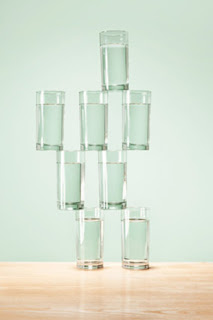కొన్ని ఆహార పదార్దములు ->>










ఆధారపడి పనిచేస్తుంది . ఆ శక్తి మనము అందించే ఇంధనం పై ఆధారపడుతుంది . మనం తినే ఆహారమే సదరు ఇందనము . ప్రతి శారీరక భాగము పనిచేయడానికి , మరమ్మతు చేసుకోవడానికి , పునరుజ్జీవనం పొందడానికి శక్తి అవసరం ... శరీరానికి చాలినన్ని పోషకాల్ని అందించినప్పుడే ప్రతి అవయవము తన పని తానూ సక్రమం గా చేసుకుంటూ పోతుంది . అనేక రుగ్మతల నుంచి కాపాడే 'యాంటి ఆక్షి డెంట్స్' (Anti Oxydents)' , సహజ చెక్కెరలు , పీచు , జీరో ఫ్యాట్ , నీటి శాతము ఎక్కువగా ఉంది తేలిక గా జీర్ణమయ్యే పండ్లు ,కూరగాయలు వీలైనంత ఎక్కువగా తినాలి . దైనందిన ఆహారము లో పండ్లు , కూరగాయలు భాగం చేసుకునే వారికి కొన్ని రకాల దీర్ఘకాలిక రుగ్మతలు కలిగే అవకాశమూ తక్కువ గా ఉంటుంది . స్నాక్స్ గా పండ్లు తేనే అలవాటు చేసుకోవాలి , పొద్దు తిరుగుడు , నువ్వులు , అవిసె , చిక్కుడు జాతి , వేరుశనగలు వంటి గింజలు ను , గోధుమ , బియ్యం , ఓట్స్ వంటి ధాన్యాలను ,తగు మోతాదులో తీసుకుంటా ఉండాలి . వాల్ నట్స్ , బాదం , జీడిపప్పు , పిస్తా , ఖర్జూరం వంటివి కొద్ది కొద్ది గా తినాలి . కొవ్వుపదర్ధములు చాలా తక్కువ గా తీసుకోవాలి . ఆహారము లో నూనె వాడకం అంతంత మాత్రం గా ఉండాలి . వేపుడు కూరలు , ఉరగాయలు , పాపడ్స్ , సీతలపానీయలు , ఐస్ కరీం లు మానేయాలి . ----------------------------------ఆరోగ్యమే మహాభాగ్యము ------------- ఆరోగ్యానికి ఆహారము : లేచినప్పటి నుండి అర్ధరాత్రి దాకా పరుగెత్తే యాంత్రిక జీవనము లో చుట్టూ పొగ , ధూళి , రసాయనాలతో కలుషితమైన వాతావరణములో సగటు మనిషి నుండి మేధావి దాకా మంచి ఆహారము గుర్తించడము కస్టమైన పని అవుతుంది . రోడ్డు మీద ఫాస్ట్ ఫుడ్ వంటివాటివల్ల పొట్ట పెరగడం , మలి వయసులో మధుమేహము , రక్తపోటు వంటివి రావడం మినహా మంచి జరగడం లేదు . ఒక ప్రాంతాన్ని , ఒక కాలాన్ని బట్టి కాక విశ్వనీయతతో ప్రకృతి ... దైవత్వాన్ని ఆకళింపుచేసుకొని , వాతావరణ మార్పులను అనుసంధానము చేసుకొని ఆహారాన్ని , ఆహారపదార్ధాల నిర్మాణాన్ని , ఆహార నియమాలను ప్రతిపాదించింది . అందుకే మనమెక్కడున్నా ప్రకృతిలోంచి వచ్చిన , వండిన , సమగ్రమైన , సమతుల్య ఆహారాన్ని తీసుకోవాలి . అన్నము బ్రహ్మ స్వరూపము , రసము విష్ణు స్వరూపము , భోజనము చేసే తను మహేశ్వర రూపమని భావించి ... అన్నము ప్రాణమయమని మంచి మనసు తో , ఆనందముతో , నలుగురుతో కలిసి , సమయాన్ననుసరించి తీసుకోవాలి .










ఆధారపడి పనిచేస్తుంది . ఆ శక్తి మనము అందించే ఇంధనం పై ఆధారపడుతుంది . మనం తినే ఆహారమే సదరు ఇందనము . ప్రతి శారీరక భాగము పనిచేయడానికి , మరమ్మతు చేసుకోవడానికి , పునరుజ్జీవనం పొందడానికి శక్తి అవసరం ... శరీరానికి చాలినన్ని పోషకాల్ని అందించినప్పుడే ప్రతి అవయవము తన పని తానూ సక్రమం గా చేసుకుంటూ పోతుంది . అనేక రుగ్మతల నుంచి కాపాడే 'యాంటి ఆక్షి డెంట్స్' (Anti Oxydents)' , సహజ చెక్కెరలు , పీచు , జీరో ఫ్యాట్ , నీటి శాతము ఎక్కువగా ఉంది తేలిక గా జీర్ణమయ్యే పండ్లు ,కూరగాయలు వీలైనంత ఎక్కువగా తినాలి . దైనందిన ఆహారము లో పండ్లు , కూరగాయలు భాగం చేసుకునే వారికి కొన్ని రకాల దీర్ఘకాలిక రుగ్మతలు కలిగే అవకాశమూ తక్కువ గా ఉంటుంది . స్నాక్స్ గా పండ్లు తేనే అలవాటు చేసుకోవాలి , పొద్దు తిరుగుడు , నువ్వులు , అవిసె , చిక్కుడు జాతి , వేరుశనగలు వంటి గింజలు ను , గోధుమ , బియ్యం , ఓట్స్ వంటి ధాన్యాలను ,తగు మోతాదులో తీసుకుంటా ఉండాలి . వాల్ నట్స్ , బాదం , జీడిపప్పు , పిస్తా , ఖర్జూరం వంటివి కొద్ది కొద్ది గా తినాలి . కొవ్వుపదర్ధములు చాలా తక్కువ గా తీసుకోవాలి . ఆహారము లో నూనె వాడకం అంతంత మాత్రం గా ఉండాలి . వేపుడు కూరలు , ఉరగాయలు , పాపడ్స్ , సీతలపానీయలు , ఐస్ కరీం లు మానేయాలి . ----------------------------------ఆరోగ్యమే మహాభాగ్యము ------------- ఆరోగ్యానికి ఆహారము : లేచినప్పటి నుండి అర్ధరాత్రి దాకా పరుగెత్తే యాంత్రిక జీవనము లో చుట్టూ పొగ , ధూళి , రసాయనాలతో కలుషితమైన వాతావరణములో సగటు మనిషి నుండి మేధావి దాకా మంచి ఆహారము గుర్తించడము కస్టమైన పని అవుతుంది . రోడ్డు మీద ఫాస్ట్ ఫుడ్ వంటివాటివల్ల పొట్ట పెరగడం , మలి వయసులో మధుమేహము , రక్తపోటు వంటివి రావడం మినహా మంచి జరగడం లేదు . ఒక ప్రాంతాన్ని , ఒక కాలాన్ని బట్టి కాక విశ్వనీయతతో ప్రకృతి ... దైవత్వాన్ని ఆకళింపుచేసుకొని , వాతావరణ మార్పులను అనుసంధానము చేసుకొని ఆహారాన్ని , ఆహారపదార్ధాల నిర్మాణాన్ని , ఆహార నియమాలను ప్రతిపాదించింది . అందుకే మనమెక్కడున్నా ప్రకృతిలోంచి వచ్చిన , వండిన , సమగ్రమైన , సమతుల్య ఆహారాన్ని తీసుకోవాలి . అన్నము బ్రహ్మ స్వరూపము , రసము విష్ణు స్వరూపము , భోజనము చేసే తను మహేశ్వర రూపమని భావించి ... అన్నము ప్రాణమయమని మంచి మనసు తో , ఆనందముతో , నలుగురుతో కలిసి , సమయాన్ననుసరించి తీసుకోవాలి .
- అమ్మ చేసిన సున్నివుండలలో వీర్యబలము ఉన్నది ,
- నువ్వుల వుండలలో స్త్రీ హార్మోను లను క్రమబద్ధము చేసే గుణము ఉన్నది ,
- పాయసము లో శక్తి ని , తృప్తిని , ఇచ్చే గుణము ఉన్నది ,
- పాలు , నెయ్యి, తేనె మధురపదార్ధాలేకాదు .. సప్తధాతువులకు శక్తి నిస్తాయి .
- తీపి --- మనలో శక్తిని పెంచుతాయి ,
- కారము --జీర్ణ శక్తి ని పెంచుతుంది ,
- చేదు --జ్ఞాపక శక్తిని , రక్టశోధనని కలుగజేస్తుంది ,
- ఉప్పు -- ఆహారానికి రుచునిచ్చి ఆమ్ల , క్షార గుణాలను సమతుల్యము చేస్తుంది ,
- వగరు --కఠిన పదార్ధాలను ముక్కలు చేస్తుంది ,
- పులుపు ---జీర్ణ శక్తిని పెంచుతుంది .










